Today I’d like to talk about exactly what to do when you sense an avoidant withdrawing from you.
My general rule of thumb has always been, “When they pull back, you pull back,” and it’s served me incredibly well.
But why? Well, that’s what we are going to explore today.
I’m going to take you through the following,
- Showing you why avoidants tend to withdraw
- Why it’s important to understand the anxious and avoidant connection
- Exploring the “Why they pull back, you pull back” mentality
- The difference between fearful avoidants and dismissive avoidants
- What avoidants want above all
There’s a lot to cover today so let us begin!

What Are Your Chances of Getting Your Ex Boyfriend Back?
Take the quizWhy Avoidants Tend To Withdraw
Let’s first talk about why avoidants tend to withdraw. I really think it comes back to this idea of distilling insecure attachments down to their simplest form, which is core wounds.
Typically speaking, when it comes to any of the insecure attachment styles, there’s always a core wound that will trigger any kind of insecure, anxious, avoidant, or fearful avoidant behavior.
- For a dismissive avoidant, that core wound revolves around a fear of losing independence.
- For someone with an anxious attachment style, that core wound revolves around a fear of abandonment.
So in both cases, if either person enters into a relationship where they feel as if they’re going to lose independence or they feel as if they’re going to be abandoned, they will react in ways that are incredibly avoidant or incredibly anxious.
The reason I’m talking about these two specific attachment styles is that we’re going to be discussing them a lot.
Our average client tends to have an anxious attachment style,
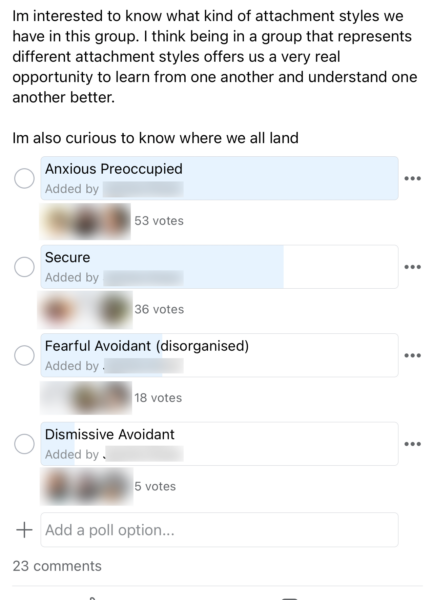
While the exes they’re often trying to get back or move on from tend to have dismissive avoidant attachment styles.
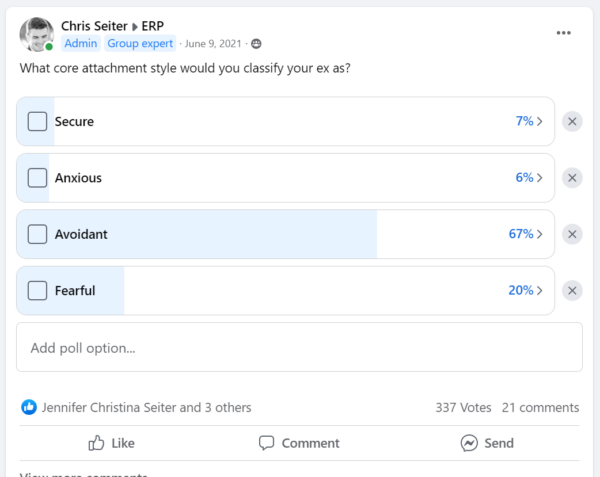
So a lot of our research has been directed towards those two forms of attachment theory.
I always find it interesting, though, that dismissive avoidants, in particular, have what I consider to be a trigger point.
Everyone always wants a one-size-fits-all explanation for why avoidants act a certain way, but the reality is that human beings are not so simple. What may set off one dismissive avoidant might not set off another. And that’s when I came up with the concept of trigger points. Each avoidant has a different threshold of what they’re willing to tolerate before their need for independence overwhelms them.
The trigger points always revolve around something that makes the dismissive avoidant feel as if their independence is being threatened.
- In a relationship context, it can be as simple as entering into a relationship.
- It could be something like going ring shopping
- Having a big talk about solidifying your relationship, or taking it to the next step.
- Sometimes it’s as simple as meeting your parents for the first time
- When they meet your parents, and your mom winks at them and asks, “So, when am I going to have grandkids?”
- Having a child
- Getting married
- Or moving in together can all be trigger points.
It just depends on the particular avoidant.
But before we actually talk about the “withdrawing part” of this let’s talk about the anxious and avoidant connection a bit.
The Anxious & Avoidant Connection
So, like I said, the average pairing we tend to study is an anxious client with an avoidant ex.
There are no two attachment styles attracted to one another that are further from core values than someone with an anxious attachment style and someone with an avoidant attachment style.
And yet, consistently, these two different individuals with such attachment styles attract one another.
The attraction, in my opinion, is often due to this unconscious desire to fulfill unmet emotional needs from childhood. Your attachment style is often informed by your upbringing. Anxious individuals are often drawn to avoidants because they represent the emotional connection they crave. Conversely, avoidants may find that their anxious partner’s neediness affirms their independence. The anxious partner may want to be more detached, and the avoidant partner may seek the intimacy they feel they lack, but these traits can also be a source of conflict over time.
So, I’m famous for doing this concept called the death wheel when it comes to attachment styles.
In my opinion, every insecure attachment style is caught in this sort of self-fulfilling death wheel.

What Are Your Chances of Getting Your Ex Boyfriend Back?
Take the quizTake a look at the anxious death wheel and the avoidant death wheel.
The anxious death wheel has eight stages.
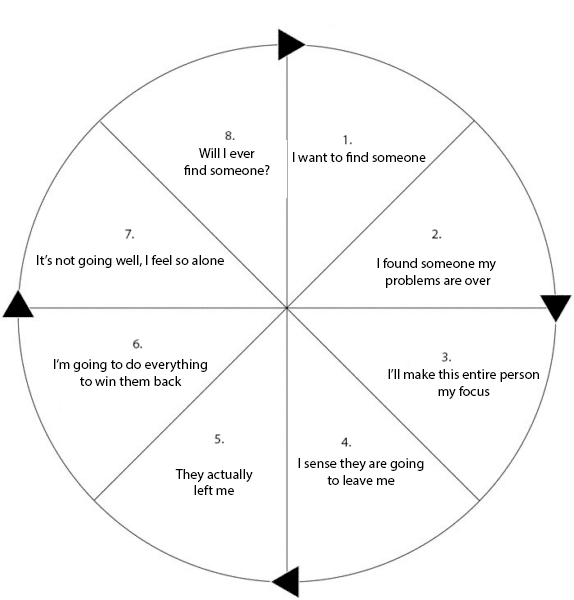
- Stage 1: I want to find someone.
- Stage 2: I found someone; my problems are over.
- Stage 3: I’ll make this entire person my focus.
- Stage 4: I sense my ex is going to leave me.
- Stage 5: The ex actually leaves me.
- Stage 6: I’m going to do everything to win them back.
- Stage 7: It’s not going well; I feel so alone.
- Stage 8: Will I ever find someone? That’s when the depression kicks in, and we start the whole cycle over again.
That’s the anxious death wheel.
Now compare that to the avoidant death wheel.
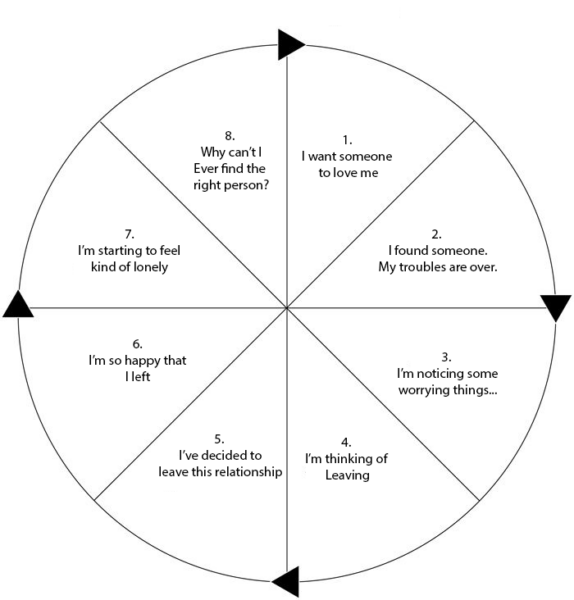
- Stage 1: I want someone to love me.
- Stage 2: I found someone; my problems are over.
- Stage 3: I’m noticing some worrying things.
- Stage 4: I’m thinking of leaving.
- Stage 5: I’ve decided to leave the relationship.
- Stage 6: I’m so happy that I left.
- Stage 7: I’m starting to feel kind of lonely.
- Stage 8: Why can’t I ever find the right person?
Now, if you overlay these two death wheels, an interesting phenomenon occurs.
They essentially start off the same.
- In both cases, the death wheels start with the anxious and the avoidant wanting someone to love them.
- In both cases, they find someone and convince themselves that their problems are over, also known as the honeymoon period.
- They start to branch off at stage 3. The anxious person wants constant reassurance and doesn’t want to do anything wrong in the relationship. So, they decide to make the avoidant person their entire focus. This, of course, triggers the avoidant person. Instead of embracing that, reassuring that, they retreat. This triggers their avoidant core wound. They start feeling like they’re losing their independence. They start noticing some worrying things.
- This makes the avoidant start thinking of leaving the anxious person, which the anxious person senses and almost doubles down on, which in turn chases the avoidant person away. This is where we sync up again.
- In both death wheels, stage 5 is “they left me” or “I left them.”
- Stage 6 is where things get really interesting. For the avoidant, stage 6 is what I call the separation elation phase. For the avoidant, it’s going to feel as if they’ve regained their independence. So, rather than being completely upset about the breakup, they’re initially overjoyed. It feels like a weight has been lifted off their shoulders. For the anxious person, the fact that the avoidant is overjoyed irks them, and they decide to do everything they can to win the avoidant back.
- Of course, if it goes well, then we start the cycle over again.
- But most of the time, it doesn’t go so well initially, and the anxious person feels completely alone, to which the avoidant also starts to feel a bit alone. Both end up at stage 8, thinking to themselves, “Why can’t I ever find someone?” And that can actually lead both of them back together again.
I have just explained why these on-again, off-again relationships between the anxious and the avoidant attachment styles are such a consistent theme that we see happening. It’s because, overlaid, their death wheels almost sync up perfectly.
But we’re kind of skirting around a big important element here, which is what the heck are you supposed to do when you sense an avoidant withdrawing
When They Pull Back, You Pull Back
Well, as I’ve just explained, our average client tends to be anxious, and they often find it incredibly difficult to give their ex space.
When someone with an avoidant attachment style withdraws, the irony is that they’re often seeking space and autonomy. So, respecting their need for distance is essentially crucial.
This is why I’ve coined the term, “when they pull back, you pull back.” It’s a mantra that I’ve talked about a lot in podcast episodes, articles throughout this entire website, and videos on YouTube. I’ve shouted this from the rooftops, yet people still don’t listen. Instead, they pressure their avoidant exes, pressuring them to open up or reconnect. Ultimately, this just causes the avoidant to withdraw further into themselves.
And I think it’s important to help you understand that when avoidants withdraw, it’s not necessarily a rejection. You know, you come back to those avoidant death wheels and look at stage three, where the avoidant notices some worrying things.
They’re only noticing some worrying things because the anxious person triggers them. The reality is their goal when they withdraw and avoid for a bit is to maintain their sense of autonomy.
And it’s that autonomy part that really interests me because, for me, it’s about the preservation of self. Avoidants often equate emotional intimacy with a loss of self, as we’ve seen with the core wound.
So, if they feel that their personal space is being encroached upon, they’re going to withdraw to preserve their sense of identity and control, in order to preserve the relationship they’re in. The anxious person just can’t let them do that, though. And this is why you get this endless cycle.
But in my research on dismissive avoidants, I’ve also come across something rather confusing.
And that’s this idea of dismissive avoidants and fearful avoidants.
There are really two types of avoidants: the dismissive kind, who have a simple core wound where they’re afraid of being abandoned, and then there are the fearful avoidants, who have two core wounds—the fear of abandonment as well as a loss of independence. My question, when looking at dismissive avoidants, was simple:
Can dismissive avoidants cycle between extreme bouts of closeness and extreme bouts of distancing?
Everything in my research indicated that this was the case, yet this is also exactly what a fearful avoidant does. So, how do you reconcile the difference between the two? What separates a dismissive avoidant distancing themselves and then becoming incredibly close, and a fearful avoidant doing the same thing?
Dismissive Avoidants Vs. Fearful Avoidants When It Comes To Closeness And Distancing
I’m going to make a confusing statement.

What Are Your Chances of Getting Your Ex Boyfriend Back?
Take the quizDismissive avoidants may cycle between closeness and distancing.
One minute they’ll be hot. The next, cold.
Here’s the problem, this sounds a lot like fearful avoidants. So, how do you differentiate between the two?
Well, both fearful avoidants (also known as anxious-avoidants) and dismissive avoidants can exhibit patterns of closeness and distancing, but they do so for different reasons and with different underlying emotional experiences.
Here’s how you can differentiate between the two:
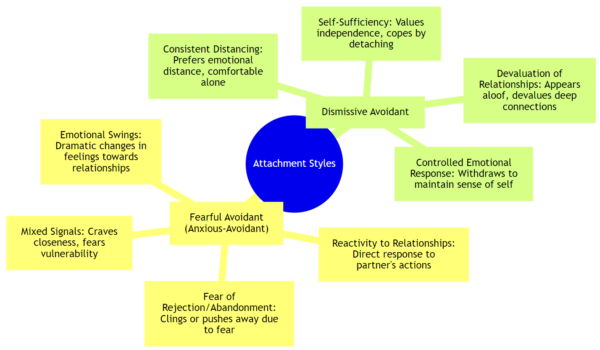
Fearful Avoidant (Anxious-Avoidant):
- Mixed Signals: Fearful avoidants send mixed signals, craving closeness but fearing the vulnerability that comes with it. They may have a more turbulent approach to relationships, with highs and lows that reflect their internal conflict.
- Reactivity to Relationships: They are highly reactive to the dynamics of their relationships. Their behavior is often a direct response to their partner’s actions—they may pursue when their partner withdraws and withdraw when their partner gets too close.
- Fear of Rejection and Abandonment: Fearful avoidants are not just afraid of intimacy; they also fear rejection and abandonment. This fear can cause them to cling to their partner when they sense a threat of abandonment but then push their partner away when they fear being too vulnerable.
- Emotional Swings: They experience more dramatic swings in their feelings towards relationships and partners, which can lead to an unpredictable push-pull dynamic.
Dismissive Avoidant:
- Consistent Distancing: Dismissive avoidants consistently prefer emotional distance and often feel most comfortable in the role of a lone wolf. They may not experience the same level of anxiety about relationships that fearful avoidants do.
- Self-Sufficiency: They pride themselves on their independence and self-sufficiency. They often cope with relationship stress by detaching completely.
- Devaluation of Relationships: Dismissive avoidants tend to devalue the importance of relationships and can appear more aloof or disinterested in deep emotional connections.
- Controlled Emotional Response: Their withdrawal is less about a fear of abandonment and more about maintaining their sense of self and autonomy. They may not experience the same intensity of emotional highs and lows in response to relationship dynamics.
While both attachment styles involve a pattern of closeness and distancing, the fearful avoidant does so in a more chaotic and emotionally volatile manner, driven by fears of both intimacy and abandonment.
In contrast, the dismissive avoidant’s pattern is more stable and less emotionally charged, driven by a preference for independence and a devaluation of emotional closeness.
What Avoidants Want Above All:
Well, I’m actually going to quote from one of my favorite resources Free to Attach,
Work to make sure they feel independence and autonomy, that there’s no pressure for them to be a certain way or move at a certain pace, and that partners aren’t overly reliant on them for their needs. Ultimately avoidants want to feel that their autonomy is respected, supported, understood and not questioned, so that if they need to be alone or on their phone for a while, that there isn’t punishment. They want to feel their behaviours are unconditionally accepted and not shamed or criticised – they likely carry a lot of internal shame about it already.
Now you see why I spent so much time talking about anxious and avoidant relationships.
There’s always this talk of the concept of love languages—like if you speak your partner’s love language or understand their love language, it can bring you closer together. What I’ve found to be interesting is that the anxious core wound or the anxious individual, from an attachment style perspective, has no clue how to operate and talk in the avoidant’s attachment language.
That’s where the “when you pull back, they pull back” approach works. Like I just stated, or rather like freetoattach.com just stated, ultimately, avoidants want to feel their autonomy is respected, supported, and understood.
They don’t want to feel as if they’re going to be punished if they feel like they need to get a little bit of space.
Yet, anxious people consistently punish avoidants.
And this isn’t necessarily the anxious person’s fault. Often, avoidants are not very good at communicating their needs. They’re not very good at verbalizing, “Hey, this is what I need. I need a little space every once in a while.”
And sometimes, the avoidant person will communicate it in a way that the anxious person just doesn’t understand. But if you understand that giving them space is okay, what you’ll find is that they end up getting closer to you and learning what it’s like to be in a secure relationship.
The problem, though, is that everyone who has an insecure attachment style should always be striving to become more secure.
Liana
October 30, 2024 at 8:06 am
thanks for info.
Michaele Bialon
November 19, 2023 at 2:05 am
Best article and advice about this subject I’ve read so far.